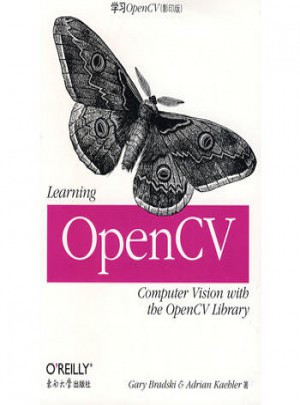
學(xué)習(xí) Open CV(影印版)
- 所屬分類:圖書 >計算機/網(wǎng)絡(luò)>影印版
- 作者:(美)[布拉德斯基],(美)[克勒] 著
- 產(chǎn)品參數(shù):
- 叢書名:--
- 國際刊號:9787564116293
- 出版社:東南大學(xué)出版社
- 出版時間:2009-04
- 印刷時間:2009-04-01
- 版次:1
- 開本:16開
- 頁數(shù):--
- 紙張:膠版紙
- 包裝:平裝
- 套裝:否

學(xué)習(xí)0penCV》將你置身于迅速發(fā)展的計算機視覺領(lǐng)域。本書作者是免費開源0penCV的發(fā)起人,這本書為你介紹了計算機視覺,例證了如何迅速建立使計算機能"看"的應(yīng)用程序,以及如何基于計算機獲取的數(shù)據(jù)作出決策。
計算機視覺幾乎隨處可見:安全系統(tǒng)、管理檢驗系統(tǒng)、醫(yī)學(xué)圖像分析、無人機等。它將Google地圖和Google地球結(jié)合在一起,在LCD屏幕上核對像素,確保襯衫上的每一個針腳都縫合。OpenCV提供了一個簡易實用的計算機視覺框架以及一個含有超過500種可以實時運行視覺代碼的函數(shù)的綜合庫。《學(xué)習(xí)OpenCV》在每一章里教授任何OpenCV的開發(fā)者或熱愛者如何在這些實戰(zhàn)經(jīng)驗的幫助下迅速掌握該軟件。這本書包括了如下內(nèi)容:
對0penCV詳盡的介紹
從照相機中導(dǎo)入圖片
轉(zhuǎn)換圖像
分割圖像和形狀匹配
模式識別,包括人臉檢測
兩到三個計量單位間的跟蹤和運動
立體視覺中的3D再現(xiàn)
機器學(xué)習(xí)算法
使機器能看見是一個具有挑戰(zhàn)卻又充滿樂趣的目標(biāo)。無論你是想建立一個簡單的還是復(fù)雜的視覺應(yīng)用程序,《學(xué)習(xí)OpenCV》都是你入門的必備教材。
"這本寶庫對專業(yè)人員來講非常有用,對初涉這個領(lǐng)域的人們也是個絕好的工具。像其宣傳的那樣,它是一組計算機視覺算法。"
——William T.Freeman.
麻省理工學(xué)院計算機科學(xué)與人工智能實驗室"《學(xué)習(xí)0penCV》即將占據(jù)每從從事計算機視覺領(lǐng)域的人的書架上顯著的一處。"
——David Lowe,英屬哥
倫比亞大學(xué)計算機科學(xué)教授Gary Rost BradSki博士,斯坦福大學(xué)人工智能實驗室的顧問教授,也是Willow Garage公司機器;人學(xué)研究協(xié)會的博學(xué)科學(xué)家。Ad rian Kaehler博士,Applied Mind S公司的博學(xué)科學(xué)家,從事機器學(xué)習(xí)、統(tǒng)計建模、計算機視覺和機器人學(xué)方面的研究。
Preface
1. Overview
What Is OpenCV?
Who Uses OpenCV?
What Is Computer Vision?
The Origin of OpenCV
Downloading and Installing OpenCV
Getting the Latest OpenCV via CVS
More OpenCV Documentation
OpenCV Structure and Content
Portability
Exercises
2. Introduction to OpenCV
Getting Started
First Program--Display a Picture
Second Program--AVI Video
Moving Around
A Simple Transformation
A Not-So-Simple Transformation
Input from a Camera
Writing to an AVI File
Onward
Exercises
3. Gettingto KnowOpenCV
OpenCV Primitive Data Types
CvMat Matrix Structure
IplImage Data Structure
Matrix and Image Operators
Drawing Things
Data Persistence
Integrated Performance Primitives
Summary
Exercises
4. HighGUI
A Portable Graphics Toolkit
Creating a Window
Loading an Image
Displaying Images
Working with Video
ConvertImage
Exercises
5. Image Processing
Overview
Smoothing
Image Morphology
Flood Fill
Resize
Image Pyramids
Threshold
Exercises
6. Image Transforms
Overview
Convolution
Gradients and Sobel Derivatives
Laplace
Canny
Hough Transforms
Remap
Stretch, Shrink, Warp, and Rotate
CartToPolar and PolarToCart
LogPolar
Discrete Fourier Transform (DFT
Discrete Cosine Transform (DCT
Integral Images
Distance Transform
Histogram Equalization
Exercises
7. Histograms and Matching
Basic Histogram Data Structure
Accessing Histograms
Basic Manipulations with Histograms
Some More Complicated Stuff
Exercises
8. Contours
Memory Storage
Sequences
Contour Finding
Another Contour Example
More to Do with Contours
Matching Contours
Exercises
9. Image Parts and Segmentation
Parts and Segments
Background Subtraction
Watershed Algorithm
Image Repair by Inpainting
Mean-Shift Segmentation
Delaunay Triangulation, Voronoi Tesselation
Exercises
10. Tracking and Motion
The Basics of Tracking
Corner Finding
Subpixel Corners
Invariant Features
Optical Flow
Mean-Shift and Camshift Tracking
Motion Templates
Estimators
The Condensation Algorithm
Exercises
11. Camera Models and Calibration
Camera Model
Calibration
Undistortion
Putting Calibration All Together
Rodrigues Transform
Exercises
12. Projection and 3D Vision
Projections
Affine and Perspective Transformations
POSIT: 3D Pose Estimation
Stereo Imaging
Structure from Motion
Fitting Lines in Two and Three Dimensions
Exercises
13. Machine Learning
What Is Machine Learning
Common Routines in the ML Library
Mahalanobis Distance
K-Means
Naive/Normal Bayes Classifier
Binary Decision Trees
Boosting
Random Trees
Face Detection or Haar Classifier
Other Machine Learning Algorithms
Exercises
14. OpenCV's Future
Past and Future
Directions
OpenCV for Artists
Afterword
Bibliography
Index
Chapter 1 oVerviw
What Is OpenCV?
OpenCV [OpenCV] is an open source (see opensource.org) computer vision library available from SourceForge.net/projects/opencvlibrary. The library is written in Cand C++ and runs under Linux, Windows and Mac OS X. There is active development on interfaces for Python, Ruby, Matlab, and other languages.
OpenCV was designed for computational efficiency and with a strong focus on realtime applications. OpenCV is written in optimized C and can take advantage of mul ticore processors. If you desire further automatic optimization on Intel architectures [Intel], you can buy Intel's Integrated Performance Primitives (IPP) libraries [IPP], which consist of low-level optimized routines in many different algorithmic areas. OpenCV automatically uses the appropriate IPP library at runtime if that library is installed.
One of OpenCV's goals is to provide a simple-to-use computer vision infrastructure that helps people build fairly sophisticated vision applicatio'ns quickly. The OpenCV library contains over 500 functions that span many areas in vision。 including factory product inspection, medical imaging, security, user interface, camera calibration, stereo vision, and robotics. Because computer vision and machine learning often go hand-inhand, OpenCV also contains a full, general-purpose Machine Learning Library (MLL).This sublibrary is focused on statistical pattern recognition and clustering. The MLL is highly useful for the vision tasks that are at the core of OpenCV's mission, but it is gen eral enough to be used for any machine learning problem.
Who Uses OpenCV?
Most computer scientists and practical programmers are aware of some facet of the role that computer vision plays. But few people are aware of all the ways in which computer vision is used. For example, most people are somewhat aware of its use in surveillance,and many also know that it is increasingly being used for images and yideo on the Web. A few have seen some use of computer vision in game interfaces.
……
例子詳細,從網(wǎng)上購書到送書上門時間為5天。
挺詳細的
幫老公的弟弟買的,正好需要。比較實用。
好書,正在看
good!!!
有些地方想看看中文……
都很不錯
這個商品不錯~
好
5.25訂的,26發(fā)的貨~我是上海的,到現(xiàn)在還沒收到,而且在26日就降價了,訂單不能取消。不知道送貨的要拖到什么時候
書到得時候已經(jīng)很陳舊了,有非常明顯的褶皺,估計就是壓倉庫的,想退貨。年前有事耽誤,現(xiàn)在肯定退不了貨了。
雖然對英語要求高,但最起碼不會誤解原文意思
確實是opencv的經(jīng)典。有中文版的,但是覺得翻譯的不是很好。還是讀原版的好!!
印刷 和紙張沒得說咯。建議有英語水平的看,畢竟還是一門外語,理解起來不如中文直接。
非常不錯的入門書籍,廣度和深度恰到好處,適合入門看。比國內(nèi)的那本OpenCV書好太多了。
非常感謝引進這本經(jīng)典的原版書,質(zhì)量很好,書的內(nèi)容非常豐富。把opencv各種數(shù)據(jù)結(jié)構(gòu)和函數(shù)原理,已經(jīng)內(nèi)在聯(lián)系解釋的非常清楚,是初學(xué)opencv非常好的參考書。建議當(dāng)當(dāng)多進影印版的英文原版書。
該書是OpenCV方面的入門基礎(chǔ)讀物,對于喜歡計算機視覺、圖像處理的人士有一定的參考價值。另外東南影印書的印刷質(zhì)量也還可以,清華的中文版就相對來講印刷差了很多,而且翻譯的也不怎么樣,建議有一定英文基礎(chǔ)的最好買影印版的看,呵呵。